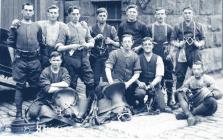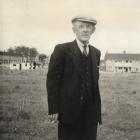Albert Crandon During WW1
Items in this story:
From 'A Childhood in Wales' - Elaine Dacey
'Albert, my grandfather from Pantyscallog, near Merthyr Tydfil, served as a soldier during WW1 and wrote a very straightforward account of his experiences which was was passed down to my father and then to me. He sets out the dates and events very methodically and in quite a dispassionate way with the odd bit of soldiers’ jargon of the time. This factual approach probably helped him cope with the horror and mayhem that was going on all around him. He signed up on 10th January 1915, aged 17 as a driver with the Royal Field Artillery, Horse Battalion, in Merthyr. He later became a team driver taking heavy guns up to the front line of battle. He had always loved horses so it seemed the best regiment to be in. (Grandpa continued to keep horses later in life. He and his brother Frederick bought a field for grazing horses between the Co-op and Garth fields in Pant)
'Albert was stationed at various places in Britain including Preston and Salisbury Plain. He set off for Le Havre in France in November 1915 from Southampton. He mentioned that they had to make three attempts to sail as they were chased back by submarines each time. It took about eleven days to finally reach their destination, a village called Saint-Jans Capple near Bailleul in northern France where they stayed for a further three weeks before being sent to Ploegsteert Wood in Flanders, Belgium in December. (Soldiers pronounced this as ‘Plugstreet Wood’).
'Albert was part of a wagon line taking the ammunition to the guns in day time. There are a number of accounts of "close shaves" and driving back the enemy. He describes one place as "a pretty warm shop" where they had "a smash up on the crossroads" nearly every night. These crossroads were at a place called ‘Suicide Corner’. He records that one night, after a direct hit from ‘Jerry’, two guns, nine gunners, five horses and three drivers "went West with that one shell". It was a 17 inch shell which he says the Germans only used for "special" targets. Albert relates that from that day their bad luck continued as they were like sitting ducks in their camp. Many more men and horses were killed and the horses were so terrified that one day they stampeded. He records that all of Whit Monday was spent burying horses and men as 54 horses and 28 men had been killed in fifteen minutes on Whit Sunday with eight planes bombing them. He said they had no need to dig graves as the holes made from the bombs were large enough for four or five horses.
'This bad luck continued for weeks but on June 7th he says "we were eager to give Jerry humpy". So at 2.30 a.m. they were all harnessed up, waiting for their advance. At about 3 a.m. the craters were blown up by the Royal Engineers. Albert explains that craters were underground tunnels which the Royal Engineers had dug and then packed with explosives. The craters were about 300 yards long and there were nine of them on a six mile front. When they exploded they "blew all the German lines to atoms and thousands of Germans besides". He wrote, "the whole earth trembled for miles. It was heard in England by Lloyd George". He continues with how they successfully went over the top and took hundreds of German prisoners. On further research, I discovered that this was the famous Battle of Messines which took place from the 7th to 14th June 1917 by the British Second Army, on the Western Front, in West Flanders where the Wytschaete Ridge was recaptured. Altogether there were 24,000 casualties and losses on the British side and 35,000 Germans.
'His account continues in this vein with advances, successes and setbacks until September 16th 1917 when he was put out of action at Ypres. He was transferred from one hospital base to another until he was back in ‘Blighty’ on September 28th to be taken to Sidcup hospital. Shrapnel had caused a serious injury and we learned later that Grandpa had a metal plate inserted in his jaw. This wasn’t at all obvious to us so they must have done a good job. He writes that he was there until January 30th 1918 and finally reported back to duty in February to the camp at Catterick in Yorkshire. For his war efforts, Albert received two medals, one for taking part in it and one for being wounded. He also received six ribbons for the battles he was in, including Ypres and Balleul (known as ‘Hell Fire Corner’; this is the place where he was wounded and taken from the front line). Albert also brought home a bayonet which has been passed down the family.
'Fortunately for Albert and all his descendants, he survived the war but never forgot his old friends. He’d often walk along Pant Road to the war memorial to read the names of the 14 men from the village who died in WW1 and there were many more from Pant and Dowlais who died in WW2.
'So after all that, at the still very young age of 22, Albert married Beatrice May Jones, and had their first child Sarah Elsie (known as Elsie) The Rhodfa’r housing estate in Pant was built in 1922 specifically for servicemen returning from the war and Albert’s family was one of the first to move in. In 1922 they also had their second child Glenys Evelyn who sadly died after about ten months. His wife Beatrice died in the same year. The cause of their deaths is now unknown. They were both buried in Pant Cemetery.'
(More about Albert’s story and second family in my America Collection).






